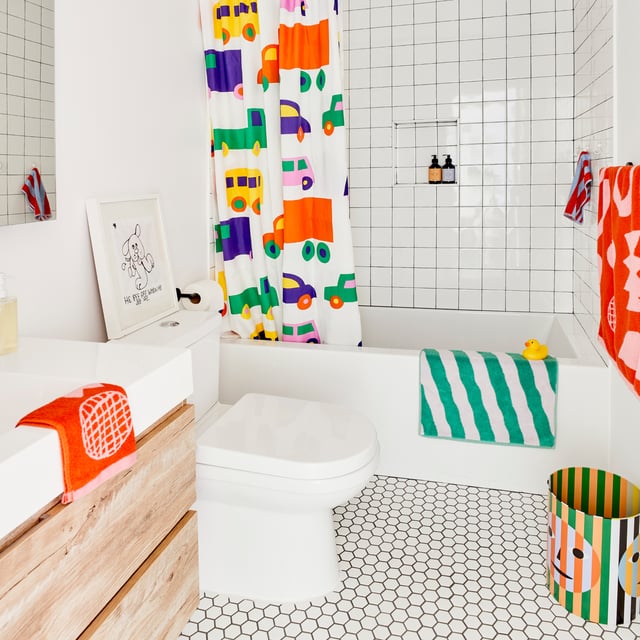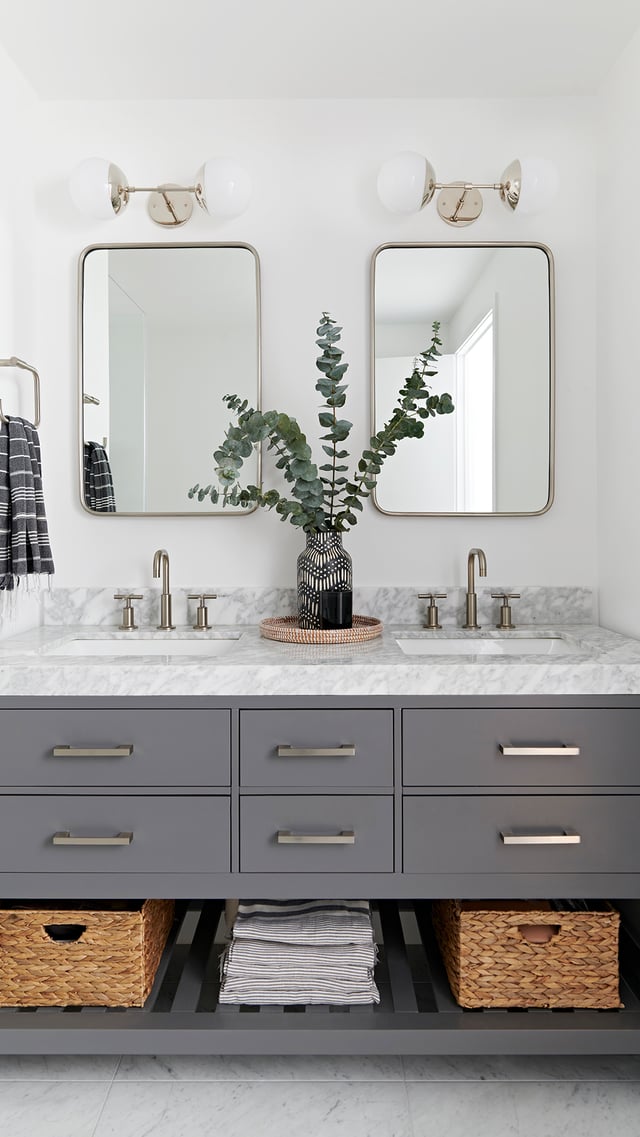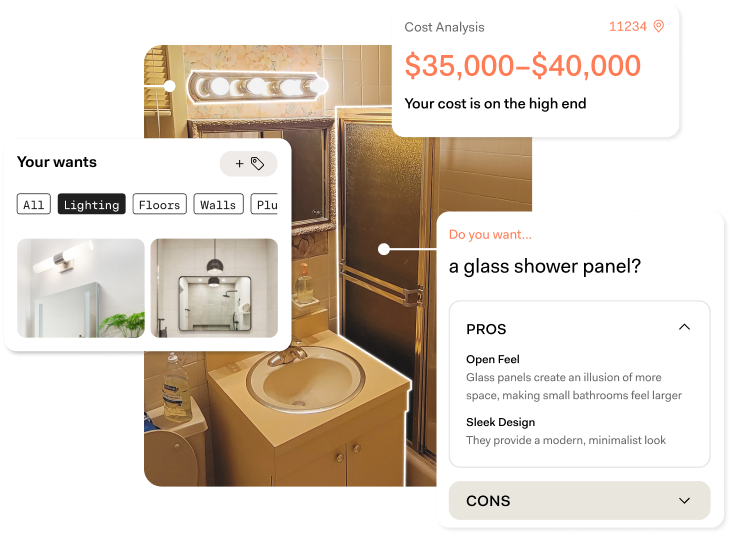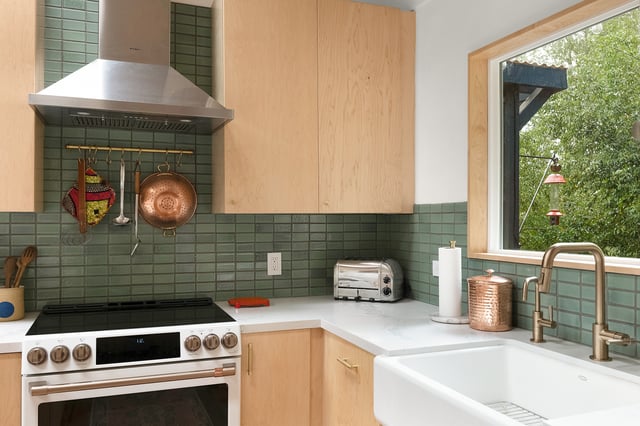
How to
Small House Renovations: Solutions for Limited Space
07.02.2025

In This Article
A bathroom vanity can make your bathroom stunning and functional. It plays a key role in organizing your space and adding a personal touch to your home's design. While hiring a professional can ensure a perfect fit, you might be surprised to learn that installing a bathroom vanity can be a rewarding DIY project. If you love hands-on work and are a little handy, doing it yourself can be just as fun as it is satisfying. In this guide, we’ll walk you through each step with clear, easy-to-follow instructions. Whether it's your first time or you're a seasoned DIYer, this article will help you transform your bathroom with confidence.
Here’s a quick overview of the whole process:
|
Installation Steps
|
Description
|
|
1. Pre-Installation Preparations
|
Prepare for installation by turning off water and checking plumbing.
|
|
2. Remove the Old Vanity
|
Safely remove the existing vanity.
|
|
3. Positioning and Securing the New Vanity
|
Measure, place, and secure the new vanity in position.
|
|
4. Installing the Faucet and Drain
|
Attach the faucet and drain correctly to the new vanity.
|
|
5. Connect the Plumbing
|
Reconnect water supply lines and ensure no leaks.
|
|
6. Finishing Touches
|
Apply caulk, install any backsplash, and clean up the area.
|
Before diving into the installation, gathering the right tools and materials is essential for a smooth process. Having everything ready ensures that you won't face interruptions. In this section, we’ll list all the tools and materials you'll need to install your new bathroom vanity successfully.
Before you begin, make sure you have all the necessary tools, like a measuring tape and a drill, to ensure precise and sturdy installation. These tools will help you measure accurately, secure the vanity, and make any adjustments needed during the process. Keeping a bucket handy is a smart tip to catch any remaining water, keeping things tidy.
Equally important are the materials required to complete your vanity installation, such as the vanity itself and silicone caulk for sealing edges. You'll need screws and mounting brackets to secure your vanity firmly in place, and plumbing tape to prevent leaks. If you're adding a new faucet and drain, make sure you have the appropriate kit ready to go.
|
Tools Required
|
Materials Required
|
|
Measuring tape
Pencil Level Drill Adjustable wrench Caulking gun Screwdriver Utility knife Bucket (for catching water) |
New bathroom vanity
Silicone caulk
Screws and mounting brackets
Plumbing tape
New faucet and drain kit (if applicable)
|
Before you start installing your new bathroom vanity, it's crucial to prepare properly to avoid any hiccups along the way. Taking a few minutes to set everything in order can save time and prevent potential issues. In this section, we'll cover essential steps like turning off the water supply and removing the old vanity safely.
First, you need to locate the water valves, which are usually found under the sink. If they're not there, check nearby areas for any valves connected to your bathroom's plumbing. To turn off the water, simply twist the valves clockwise until they’re fully closed.
Next, ensure you place a bucket under the sink to catch any leftover water in the pipes. This simple step can prevent water from spilling onto your floor, keeping your work area dry and safe. Once the bucket is secure, disconnect the water lines, allowing any remaining water to drain into the bucket.
To remove the old vanity, start by carefully disconnecting the water lines using an adjustable wrench, loosening the nuts that secure the lines to the faucet. Ensure that the water lines are completely detached and drained into your bucket to avoid any spills. Take care while handling the water lines to prevent any damage to the existing plumbing.
Once the water lines are disconnected, use a screwdriver or drill to unscrew the vanity from the wall. It's important to do this gently to avoid damaging the wall surface. Lift the old vanity away carefully, and if it's bulky or heavy, consider getting help to move it. When disposing of the old vanity and materials, check with your local waste management facility for proper disposal methods, ensuring you're being eco-friendly and following local guidelines.
Before installing your new vanity, take a close look at the plumbing to ensure everything is in good shape. Check for any signs of leaks, corrosion, or wear and make sure that all connections are secure and not damaged. If you notice any issues, it might be a good idea to address them now to avoid problems later on.
If adjustments are necessary, like repositioning pipes, it's crucial to do it carefully. You might need to use a wrench to tighten loose connections or replace damaged parts with new plumbing components. If the required adjustments seem complex, consider consulting a plumbing professional to ensure everything is set correctly and safely.
Now that the old vanity is out and your plumbing is in top shape, it's time to position your new bathroom centerpiece. Making sure your new vanity is properly aligned is crucial for functionality and aesthetics. This section will guide you through measuring, placing, and securing your vanity for the best fit.
To start, you'll want to measure the space where your new vanity will go to ensure a perfect fit. Here's how you can do it:
Once you've got your measurements, it's time to mark the wall for accurate placement:
After marking the space, carefully carry your new vanity into the bathroom and position it against the wall using your previously made marks as a guide. Align the back of the vanity with your wall marks to ensure it's centered and fits snugly within the allocated space. Gently push it into place, making sure there is no gap between the back of the vanity and the wall surface.
Next, use a level to check that the vanity sits evenly both horizontally and vertically. If the vanity isn't level, use shims to make any necessary adjustments to balance it. Place the shims under the corners that need raising, and continue to adjust until the level shows a perfectly straight line. Taking the time to ensure your vanity is perfectly level will prevent problems with water flow and ensure the doors and drawers operate smoothly.
Securing your vanity to the wall ensures it's stable and safe to use. Follow these step-by-step instructions to attach it correctly:
Locate the Studs: Use a stud finder to locate the wall studs behind your vanity. Mark their locations with a pencil for reference.
Drill Pilot Holes: Using a drill, create pilot holes through the back of the vanity into the studs. These holes prevent the wood from splitting and make it easier to drive in screws.
Position Mounting Brackets: Align the mounting brackets with the pilot holes on the wall and attach them using screws. This increases the stability of your vanity.
Secure the Vanity: Once the brackets are in place, fasten the vanity to the wall by driving screws through these pilot holes into the wall studs. Double-check that all screws are tight and the vanity remains level after securing it.
Following these steps will ensure your new vanity is firmly attached to the wall, providing confidence in its stability and longevity.
With your vanity securely in place, it's time to focus on installing the faucet and drain, two essential components for a functional bathroom. Proper installation ensures everything works smoothly and prevents potential leaks down the road. In the following steps, we’ll guide you on how to attach the faucet and connect the drain assembly with ease.
Start by carefully reading the instructions included with your faucet kit, as different models may have specific requirements. Place the faucet onto the designated holes on your vanity top, ensuring it's correctly aligned and seated snugly. From beneath the countertop, secure the faucet by threading the mounting nuts onto the faucet shanks. It's essential to hand-tighten initially to keep everything in position.
Once the faucet is aligned and hand-tightened, use a wrench to secure the nuts firmly. However, be cautious not to over-tighten them, as this can cause damage to both the faucet and the vanity surface. Over-tightening may also lead to leaks by compromising the washers and seals. Double-check everything for a snug fit without applying excessive force, ensuring a perfect seal and a professional finish.
To begin installing the drain assembly, insert the drain body into the sink basin's drain hole, using the rubber gasket provided to create a seal. From underneath the sink, secure the drain with a washer and nut, tightening by hand to ensure the assembly stays in place. Make sure everything aligns properly with the basin, preventing any gaps or misalignments.
For an extra layer of leak prevention, wrap plumber's tape around the threads of the drain tailpiece before connecting it to the remaining plumbing. The tape helps create a watertight seal and reduces the chance of leaks over time. Once wrapped, tighten the tailpiece into the drain body, ensuring a secure and snug fit, while being mindful not to overtighten and damage the components. This careful assembly will ensure your sink drains efficiently without any issues.
Now that your faucet and drain assembly are in place, it's time to connect the plumbing to get everything running smoothly. Careful attention to detail during this step ensures there are no leaks and that water flows correctly. In the following sections, we’ll guide you through reconnecting the water supply lines and checking for any potential leaks.
Start by taking your supply lines and connecting them to the corresponding hot and cold water inlets on the bottom of your faucet. Hand-tighten the connectors first, making sure each line matches the correct inlet to avoid any mix-up in water temperature. Once they’re hand-tightened and properly aligned, use an adjustable wrench to finish tightening them.
It's crucial to ensure these connections are snug but be cautious not to overtighten, as this could damage the fittings or cause leaks. A firm and secure fit will prevent water from dripping when the water supply is turned back on. Double-check all connections to make certain they're tight and ready to handle the water flow once you complete the installation.
To check for leaks, begin by slowly turning on the water supply valves under the sink. This cautious approach helps prevent any sudden pressure that might displace newly connected fittings. Observe the connections around the faucet and drain closely for any signs of drips or moisture.
If you notice any leaks, carefully tighten the connections with an adjustable wrench, turning slightly until the leak stops. It's important to tighten gradually to avoid damaging the fittings. Once everything appears dry and secure, run the water for a few minutes to ensure that all parts function properly without any leaks.
With the plumbing in place and functioning smoothly, it's time to add those finishing touches that complete the look of your new bathroom vanity. These final steps ensure that your installation looks polished and professional. In the upcoming sections, we’ll guide you through applying silicone caulk, installing a backsplash (if needed), and cleaning up your workspace.
To begin sealing with silicone caulk, make sure the area where the vanity meets the wall is clean and dry to help the caulk adhere properly. Follow these steps for a neat application:
Load the Caulking Gun: Insert the silicone caulk tube into your caulking gun and cut the nozzle at a 45-degree angle to control the flow.
Apply a Steady Bead: Hold the gun at a consistent angle and squeeze the trigger smoothly to apply an even bead of caulk along the seam where the vanity meets the wall.
Smooth the Caulk: Use a damp finger or a caulk-smoothing tool to smooth the bead, pressing gently to ensure it fills the gap completely.
Clean Excess Caulk: Wipe away any excess caulk with a damp cloth to leave a clean edge and ensure a tidy finish.
Allow the caulk to fully dry according to the manufacturer’s instructions to ensure a strong, watertight seal.
If your vanity design includes a backsplash, begin by applying a suitable adhesive to the backside of the backsplash piece. Position it carefully along the top edge of your vanity, pressing it against the wall to bond. Ensure that the backsplash is aligned with the vanity's edges for a cohesive look. Use a level to check that the backsplash is evenly placed, making adjustments if necessary.
Once the adhesive has set and the backsplash is secure, apply a bead of silicone caulk along the joints where the backsplash meets the wall and vanity. This step seals the edges, prevents water from seeping behind the surfaces, and gives a finished appearance. Smooth the caulk with a damp finger or tool for a neat finish, and allow it to dry completely as per the manufacturer’s guidelines. This installation will enhance both the aesthetics and functionality of your vanity area.
You can also check out this guide for more tile ideas.
Once your installation is complete, take some time to clean the new vanity and the surrounding area. Use a soft cloth and mild cleaner to wipe down all surfaces, removing dust, fingerprints, and any stray bits of caulk or adhesive. Pay special attention to cleaning around the edges and corners to ensure your vanity sparkles.
For post-installation care, regularly check the plumbing connections for any signs of leaks, which can often occur within the first few weeks after installation. Also, routinely clean the surfaces with non-abrasive cleaners to maintain the finish and prevent dulling. By following these care steps, your new bathroom vanity will continue to look great and function well for years to come.
Even with careful installation, you might encounter a few common issues that need addressing to keep your vanity functioning optimally. Knowing how to handle these problems effectively can save time and prevent further complications. Here are some potential issues and suggestions for when it might be best to call in a professional:
Water Leaks: Frequently check your plumbing connections for any leaks. Tighten connections gently if necessary, but if leaks persist, it might be time to consult a plumber.
Misalignment: If you notice your vanity or backsplash isn't sitting level, adjust using shims or by repositioning. Persistent misalignment could mean a more comprehensive fix requiring professional help.
Loose Fixtures: Faucets and drain assemblies may become loose over time. Regularly ensure fittings are secure, but if tightening doesn’t resolve the issue, a professional can ensure everything is correctly installed.
Sealant Problems: If caulk around your vanity cracks or pulls away, clean the old material and apply a fresh line of silicone. For large or recurrent sealant issues, a contractor can help properly seal your bathroom elements.
Slow Drainage: Any signs of slow drainage or clogs can often be fixed with a household drain cleaner. If the problem persists, especially after attempts to clear it, calling a plumber may be necessary to prevent damage.
When working with plumbing and tools, keeping safety in mind is crucial. Always wear protective gear such as gloves and goggles to safeguard against sharp edges and debris. Be sure to turn off the water supply before starting any plumbing work to prevent accidental flooding, ensuring a smooth and safe renovation experience.
Choosing the ideal vanity for your bathroom involves balancing style and functionality. Accurately measure your space to guarantee a perfect fit, and select a design that complements your bathroom’s aesthetics. For more inspiration, explore this guide on luxury modern master bathroom ideas to find options that offer storage and meet your functional needs effortlessly.
Opt for eco-friendly materials to make your renovation more sustainable, like bamboo or reclaimed wood for your vanity. This not only reduces environmental impact but can also enhance your bathroom's look. To minimize waste, carefully plan each installation step and recycle packaging materials whenever possible, making your project both beautiful and planet-friendly.
Installing a bathroom vanity might seem daunting at first, but with the right preparation and a bit of patience, it can be a straightforward DIY project. Taking the time to gather the necessary tools and follow each step carefully ensures a smooth and successful installation.
Remember, minor challenges can be resolved with a little troubleshooting, giving you confidence in your abilities. By completing this project yourself, you not only enhance your home's functionality and style but also gain valuable experience and satisfaction.
What type of vanity is best for a small bathroom?
How do I choose the right size vanity for my space?
Can I install a bathroom vanity without a backsplash?
What should I do if my vanity doesn’t align with existing plumbing?
How can I make sure my vanity is level on an uneven floor?

Calculate the true cost of your bathroom remodel
Get real-time cost estimates for materials and labor, so you can budget your renovation with confidence—no guesswork.

How to
Small House Renovations: Solutions for Limited Space
07.02.2025

Remodeling
Does Homeowners Insurance Cover Renovations?
05.22.2025

Remodeling
What’s the Difference Between a Home Renovation and a Remodel?
05.22.2025

Remodeling
How to Renovate in Brooklyn
05.22.2025

Finance
The Top Renovations That Increase Home Value in 2025
05.22.2025
Renovate confidently